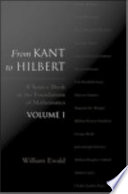 | William Bragg Ewald - Mathematics - 2005 - 696 pages
...ratio of the quantities not before they vanish, nor afterwards, but with which they vanish. Equally, the first ratio of nascent quantities is that with...that with which they begin and cease to be (or to be increased or diminished). There is a limit which the velocity at the end of the motion may attain,... | |
 | Mary Tiles - Mathematics - 2004 - 276 pages
...be understood that ratio not before they vanish, nor afterwards, but with which they vanish. . . . There is a limit which the velocity at the end of the motion may obtain, but not exceed. This is the ultimate velocity. And there is the like limit in all quantities... | |
 | John Lane Bell - Mathematics - 2005 - 354 pages
...understood the ratio of the quantities not before they vanish, nor afterwards, but with which they vanish. In like manner the first ratio of nascent quantities is that with which they begin to be. ... 1 Newton (1962), p. 29 The 16th and 17th Centuriesithe Founding of the Infinitesimal Calculus 85... | |
| |